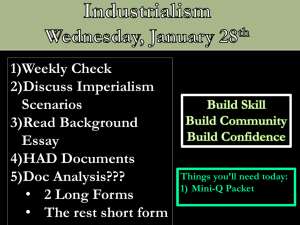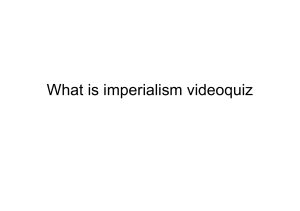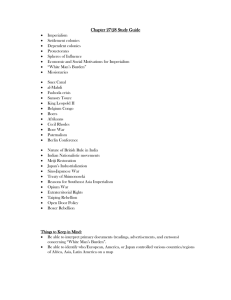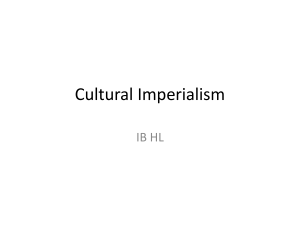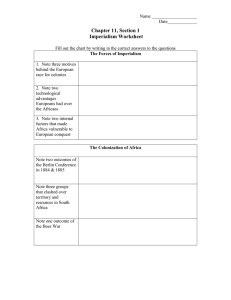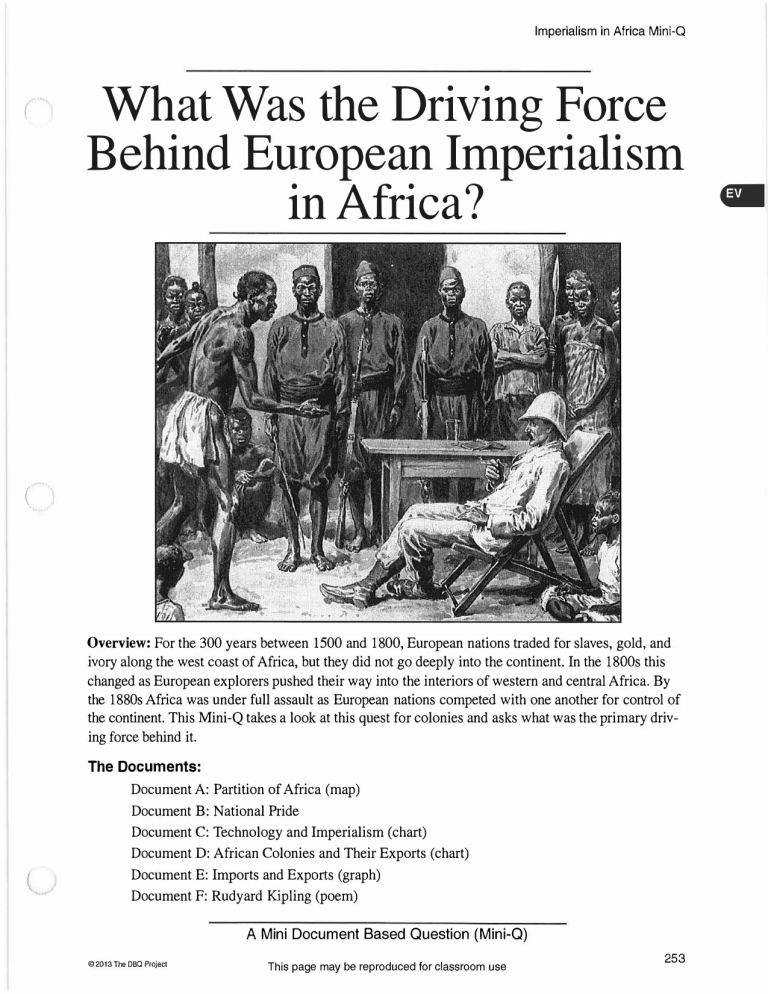
Imperialism in Africa Mini-Q
(
What Was the Driving Force
Behind European Imperialism
in Africa?
(
Overview: For the 300 years between 1500 and 1800, European nations traded for slaves, gold, and
ivory along the west coast of Africa, but they did not go deeply into the continent. In the 1800s this
changed as European explorers pushed their way into the interiors of western and central Africa. By
the 1880s Africa was under full assault as European nations competed with one another for control of
the continent. This Mini-Q takes a look at this quest for colonies and asks what was the primary driv­
ing force behind it.
The Documents:
Document A: Partition of Africa (map)
Document B: National Pride
Document C: Technology and Imperialism (chart)
Document D: African Colonies and Their Exports (chart)
Document E: Imports and Exp01ts (graph)
Document F: Rudyard Kipling (poem)
A Mini Document Based Question (Mini-Q)
©2013 The DBO Project
This page may be reproduced for classroom use
253
-
Imperialism in Africa Mini-Q
Hook Exercise: Is Imperialism Ever Justified?
Directions: Imperialism is an action by a strong nation to take control of another country. For
example, the United States was practicing imperialism when it took control of the Philippines in
1899. Throughout history, nations have turned to imperialism for a variety of reasons. Below are five
different scenarios, each presenting a different reason for taking control of a country. Next to each
scenario check whether imperialistic action is always justified, sometimes justified, or never justified.
In each case, provide your rationale, that is, the reasons behind your thinking.
Scenario
(
Always
Justified
Sometimes
Justified
Never
Justified
1. National security: The colonized island country bas
deepwater ports for refueling the mother country's
navy and merchant marine.
It also has an airfield.
D
D
D
2. National economy and
energy independence: The
colonized country has
much needed oil reserves.
D
D
D
3. Moral duty: The colonized
country has a poor, uneducated population that
needs roads, schools, and
hospitals.
D
D
D
4. Establishing religious
freedom: The colonized
country is ruled by a brutal
theocracy. Christians,
Muslims, Hindus, and
Jews are denied freedom
of worship upon pain of
death.
D
D
D
5. Establishing political
freedom: The colonized
country is run by a tyrant
who denies free elections
and imprisons all critics.
D
D
D
©2013 The 080 Project
This page may be reproduced for classroom use
Rationale
255
-
Background Essay
Imperialism in Africa Mini-Q
What Was the Driving Force Behind European Imperialism in Africa?
(
(
Before the 19th century, Europeans knew
very little about the interior of Africa. Between
1500 and 1800, European presence in Africa was
mostly about buying and selling slaves from local
chiefs. Slave ships would arrive, trade their pots,
cloth and guns for West African slaves, then set
sail for the Americas. These ships anchored off the
African coastline and their crews seldom left the
ship because of the risk of catching malaria or
other tropical diseases. Europeans were so
vulnerable to these diseases that the west coast of
Africa, from the Senegal River to Angola, became
known as "the white man's
grave."
In 1807, the British out­
lawed the trans-Atlantic slave
trade and in 1833, slavery
itself. With the end of slavery,
European interests in the con­
tinent shifted to imperialism
and seizing colonies. Serious
exploration began. Scotsman
Mungo Park gave his life in
1806 while investigating the
Niger River region in
West Africa. In 1840 David
Livingston began more than
thirty years in the interior of
central Africa. Whereas maps
of Africa drawn in 1800 had left great holes in the
continent's center, by 1850 some of the blanks
were filling in. Still, as late as 1870 only 10% of
Africa was under European control, and most of
that was along the edges - French Algeria, British
Sierra Leone, Portuguese Angola.
King Leopold of Belgium broke this pattern.
In the early 1880s he acquired a private "country"
of 900,000 square miles in central Africa.
Leopold called his estate Congo Free State.
Leopold's Congo was 95 times the size of
Belgium and his purpose was to make money
by taking out ivory and rubber. Over the next
twenty years Leopold's managers proceeded to
kill, through forced labor, horrible mistreatment,
©2013The 080 Project
and the introduction of disease, as many as
10,000,000 people. It was not a good beginning
for European imperialism in Africa.
During the same years that Leopold was
buying the Congo, other European leaders were
becoming very aware of two things: First, Africa
was filled with incredible natural resources; sec­
ond, a scramble for these riches could lead to war
among the European powers. Otto van Bismarck
of Germany proposed that a conference be held
in Berlin in 1884 and 1885 to divide up Africa
in a reasonable and peaceful manner. No Africans
were invited to attend. At the
conference, the European
nations (all except Switzer­
land attended) divided up the
African continent by claim
and by the rule of
occupation. It was not
enough, for example, for
England to claim Nigeria.
England also had to prove
that it had treaty agreements,
buildings, soldiers, and
administrators on the ground
to support their claim. At
Berlin, the European nations
also agreed to certain
principles regarding coloni­
zation. These included free trade, the elimination
of slavery, respect for each other's territorial
claims, and improving the "moral and material
well-being" of Africans. They did not, however,
consider the land claims of Africans.
This short background brings us to the ques­
tion asked by this Mini-Q. For more than three
centuries Europeans had avoided the Afiican
interior. Now, powers like England, France, and
Germany showed a fresh interest in getting and
holding large pieces of the African continent.
But why this new interest? More specifically, in
the late 19th Century, what was the driving force
behind European imperialism in Africa?
This page may be reproduced for classroom use
257
-
Imperialism in Africa Mini-Q
Background Essay Questions
(
1. Between 1500 and 1800 what was a main reason Europeans did not enter the interior of Africa?
2. What is the difference between ending the slave trade and ending slavery?
3. What is the connection between a man like Mungo Park and imperialism?
4. What percentage of Africa had been colonized by 1870?
5. What likely explains the poor standing of Leopold II among historians today?
6. When was the Berlin Conference and what did it do?
7. What place were Africans given at the conference table in Berlin?
8. Define the following terms:
malaria
trans-Atlantic slave trade
(
imperialism
forced labor
rule of occupation
free trade
Timeline
1806 - Mungo Park dies exploring the Niger River.
1807 -Britain abolishes the trans-Atlantic slave trade.
1830 - The French occupy Algeria.
1833 - Britain abolishes slavery.
1869 - The French complete building the Suez Canal in Egypt.
1872 - King Leopold II of Belgium begins to acquire land in the Congo River region.
1884 - The Berlin Conference begins to divide up Africa.
1914 - World War I begins in Europe.
©2013 The DBO Project
This page may be reproduced for classroom use
259
Imperialism in Africa Mini-Q
Understanding the Question and Pre-Bucketing
(
-
Understanding the Question
1. What is the question asked by this Mini-Q?
2. What terms in the question need to be defined?
3. Rewrite the question in your own words.
Pre-Bucketing
Directions: Using clues from the Mini-Q question, think of possible analytical categories and label
the buckets.
(
/
© 2013 The DBO Project
This page may be reproduced for classroom use
261
Imperialism in Africa Mini-Q
Document A
(
Source: Map created from various sources.
-
Partition of Africa, 1884-85
Madeira Is.
(Porlug.11),..
(
S�oTom/
(Portugal)
ATLANTIC
OCEAN
IND IAN
OCEAN
European Colonies
l2J Portuguese
O British
O French
� Belgian
� Italian
O Independent African
� German
• Spanish
states
0
0
300
600 Miles
300 600 Kilometers
Document Analysis
1. How many European countries held African colonies by 1914?
2. Which two European countries were the biggest winners in the race to seize African colonies?
3. Britain had a dream of building a railroad from the Mediterranean Sea to South Africa (i.e. from Cairo
to Cape Town). Which country was in the strongest position to block this from happening?
4. By 1885, what were the only two African countries to remain independent?
5. How could this document be used to explain a driving force behind European imperialism in Africa?
@ 2013 The DBQ Project
This page may be reproduced for classroom use
263
Imperialism in Africa Mini-Q
Document B
(
Source: John Ruskin, lecture at Oxford University, February 8, 1870.
-
Note: John Ruskin {1819-1900) was a well regarded English intellectual, author, and speaker
whose interests ranged from art critic to social reformer. This talk at Oxford University
was delivered to a standing room only crowd. A short excerpt follows.
[Will the] youths of England, make your country again a royal throne of kings; ... for all
the world a source of light, a center of peace? ... (T)his is what [England] must either do
or perish: she must found colonies as fast and as far as she is able, formed of her most
energetic and worthiest men; - seizing every piece of fruitful waste ground she can set her
foot on, and there teaching these her colonists ... that their first aim is to be to advance the
power of England by land and by sea.
Source: Freidrich Fabri, Does Germany Need Colonies? 1879.
Note: Freidrich Fabri (1824-1891) has been called the "father of the German colonial move­
ment." Fabri was impressed by the colonial achievements of the English and wanted
Germany to do something of the same. His book was quite well received.
(
But should not the German nation who is fundamentally so very capable, so seaworthy, so
industrially and commercially minded ... successfully pave the way for this new course?
... It would be wise if we Germans would learn about colonial skills from our Anglo­
Saxon [British] cousins and would begin-in a friendly competition-to strive after them.
When the German Reich centuries ago was at the peak of the states in Europe, it was
the Number One trade and sea power. Should the New German Reich wish to prove and
maintain its newly won position of power for a long time, it will have to take up the same
culture-mission and delay no longer to acknowledge its colonial task anew.
Document Analysis
1. What does Ruskin say England must do to again be "a source of light, a center of peace"?
2. What does he say should be the colonists' "first aim"?
3. According to Fabri, what were Germany's strengths when it was "at the peak of the states in
Europe"?
4. Why does Fabri believe that Germany needs to "strive after" colonies?
5. What is the driving force behind European imperialism in Africa, according to these two sources?
© 2013 The 080 Project
This page may be reproduced for classroom use
265
Imperialism in Africa Mini-Q
Document C
(
Source: Information drawn from various sources.
Note: The Industrial Revolution led to many discoveries and inventions that helped Europeans to take over Africa.
Technology and Imperialism
(
Technological Development
(Date Invented)
Use and Significance
Steam engine (1787) first used in boats;
(1804) first used in locomotives
A more constant and forceful source of power
than sails on ships or horse-drawn carriages.
Faster form of transportation
Method of getting quinine from
cinchona tree bark (1820)
Treatment for the disease malaria
Electric telegraph (1837)
Communication over long distances
Bessemer process (1855)
Quicker and cheaper method of manufacturing
steel, which was lighter and more durable than iron;
used in producing rails, bridges, and tall buildings
Maxim gun (1884)
First machine gun
Repeating rifle (late 1800s)
A faster-loading gun that was able to fire multiple
shots more accurately than older muskets
Document Analysis
1. During which century was most of the technology in this chart invented?
2. Which technological advancement cured a tropical disease? Which of the technological develop­
ments gave European armies an advantage over African armies?
3. Which of the inventions do you think would have been the most important for spreading European
influence in Africa?
4. How could this document be used to explain the primary cause of European imperialism in Africa?
5. Was technology a better driving force behind European imperialism in Africa than national com­
petition? Explain.
© 2013 The DBO Project
This page may be reproduced for classroom use
267
-
Imperialism in Africa Mini-Q
Document D
(
Source: Information drawn from various sources.
-
Selected African Colonies and Their Exports
African Colony
Resources Exported
Industrial or Economic Use
Angola
cotton
palm oil and palm-kernel oil
coffee and sugar
fabrics
soap and candles; some food products
food processing
rubber
palm oil and palm-kernel oil
ivory
waterproof clothes, tires, electrical insulation
soap and candles; some food products
handles, piano keys, billiard balls
gum
palm oil and palm-kernel oil
cotton
peanuts, bananas, coffee, cocoa
cosmetics, drugs, food products
soap and candles; some food products
fabrics
food processing
copper
zinc
lead
coal
coins, metal alloys, electrical wiring
metal alloys, rust protection
metal alloys, ammunition
fuel
gold
diamonds
banking, national currencies, jewelry
jewelry, industrial cutting tools
sisal
coffee
rubber
cotton
rope and twine
food processing
waterproof clothes, tires, electrical insulation
fabrics
(European Colonizer)
(Portugal)
Congo Free State
(King Leopold of Belgium)
French West Africa
(France)
Rhodesia
(Great Britain)
(
South Africa
(Great Britain)
Tanganyika
(Germany)
:-
,.
Document Analysis
I. What European industries benefited from African resources?
2. If you owned a textile mill, which colony or colonies would you want your country to rule? Ex­
plain.
3. The Age of Imperialism fell right on the coattails of the Industrial Revolution. What is the
connection between the two?
4. How could this document be used to explain a primary cause of European imperialism in Africa?
© 2013 The 060 Project
This page may be reproduced for classroom use
269
Imperialism in Africa Mini-Q
Document E
(
Source: Trevor Owen Lloyd, The British Empire: 1558-1995, 1996.
-
Great Britain and South Saharan Africa
Imports and Exports, 1854 and 1900
tlj 1mports from Africa
- Exports to Africa
Cl)
-0
c
:::,
0
0.
:2
·;::
15
0
c
Cl)
.Q
.E
10 1-----------------
.5
ell
5 1---------------i
(
Africa, South of Sahara
1854
Africa, South of Sahara
1900
Document Analysis
1. How much money did Great Britain make from exports to South Saharan Africa in 1854? In 1900?
2. Describe the difference between Great Britain's imports from and exports to Africa in 1854 and
1900. Which experienced a higher rate of growth?
3. According to this chart, how was Great Britain benefiting from its African colonies?
4. How could this document be used to explain an important cause of European imperialism in Africa?
u
5. Were economic factors more of driving force behind European imperialism than national pride?
Than improved technology?
©2013 The 080 Project
This page may be reproduced for classroom use
271
Imperialism in Africa Mini-Q
Document F
(
-
Source: Rudyard Kipling, ''The White Man's Burden," 1899.
Take up the White Man's burden­
Send forth the best ye breedGo bind your sons to exile
To serve your captives' need;
To wait in heavy harness,
On fluttered folk and wildYour new-caught, sullen peoples,
Half-devil and half-child...
Take up the White Man's burden­
The savage wars of peaceFill full the mouth of Famine
And bid the sickness cease;
And when your goal is nearest
The end for others sought,
Watch sloth and heathen Folly
Bring all your hopes to nought...
·-
.__�,�������������������-��tr
(
:1
i,
j;
it'
Document Analysis
1. Who is Kipling talking to when he says, "Send forth the best ye breed"?
2. Who does Kipling mean when he refers to "Your new-caught, sullen peoples,/Half-devil and half­
child"?
3. What does Kipling mean when he commands, "Fill full the mouth of Famine IAnd bid the sickness
cease"?
4. What does the title "The White Man's Burden" mean?
5. How can this document be used to explain a primary cause of European imperialism in Africa?
6. Are cultural attitudes a more important driving force behind European imperialism in Africa than
political, technological, or economic reasons? Explain.
@2013 The OBO Project
This page may be reproduced for classroom use
273
Imperialism in Africa Mini-Q
Bucketing - Getting Ready to Write
-
Task One: Bucketing
Look over all the documents and organize them into your final buckets. Write labels under each
bucket and place the letters of the documents in the buckets where they belong. Remember, your
buckets are going to become your body paragraphs. You may want to organize your buckets so
that your main driving force or reason is in the last bucket.
(
Thesis Development and Road Map
On the chickenfoot below, write your thesis and your road map. Your thesis is always an opinion and
answers the Mini-Q question. The road map is created from your bucket labels and lists the topic
areas you will examine in order to prove your thesis.
© 2013 The 080 Project
This page may be reproduced for classroom use
275
Imperialism in Africa Mini-Q
From Thesis to Essay Writing
(
Mini-Q Essay Outline Guide
-
Working Title
Paragraph #1
Grabber
Background
Stating the question with key terms defined
Thesis and road map
Paragraph #2
Baby Thesis for bucket one
Evidence: Supporting detail with document citation
Argument: Connecting evidence to the thesis
(
Paragraph #3
Baby Thesis
Evidence
Argument
Paragraph #4
Baby Thesis
Evidence
Argument
Paragraph #5
Conclusion: "Although" statement followed by restatement of your main idea
© 2013 The OBO Project
This page may be reproduced for classroom use
277
Imperialism in Africa Mini-Q
Student Mini-Q Lined Paper
(
(
L
©2013 The 080 Project
This page may be reproduced for classroom use
279
Imperialism in Africa Mini-Q
Student Mini-Q Lined Paper
(
(
© 2013 The OBQ Project
This page may be reproduced for classroom use
281
Criterion B: Investigating
i.
ii.
iii.
iv.
formulate a clear and focused research question and justify
its relevance
Formulate and follow an action plan to investigate a research
question
use research methods to collect and record appropriate,
varied and relevant information
evaluate the research process and results.
Level Level descriptor
0
1-2
3-4
5-6
7-8
Task-specific Objectives
1.
2.
3.
Student has a clear thesis, and the reasoning for the
thesis is explained in the introductory paragraph.
Student should show they followed an action plan by
having baby theses and the beginning of each
supporting paragraph.
Student uses 1 in-text citations per paragraph
following MLA format.
Task-specific clarifications
The student does not reach a standard described by any of Paper not submitted
the descriptors below.
The student:
i. formulates a research question that is clear or focused
and describes its relevance,
ii. formulates a limited action plan to investigate a
research question or does not follow a plan,
iii. collects and records limited information, not always
consistent with the research question,
iv. makes a limited evaluation of the process and results
of the investigation.
The student:
i. formulates a research question that is clear and
focused and describes its relevance in detail,
ii. formulates and somewhat follows a partial action plan
to investigate a research question,
iii. uses a research method(s) to collect and record
mostly relevant information,
iv. evaluates some aspects of the process and results of the
investigation.
The student:
i. ,formulates a clear and focused research question and
explains its relevance,
ii. formulates and follows a substantial action plan to
investigate a research question,
iii. uses research method(s) to collect and record
appropriate relevant information
iv. evaluates the process and results of the investigation.
1.
2.
The student:
i. formulates a clear and focused research question and
justifies its relevance,
ii. formulates and effectively follows a comprehensive action
plan to investigate a research question,
iii. uses research methods to collect and record
appropriate, varied and relevant information,
iv. thoroughly evaluates the investigation process and
results.
1.
3.
1.
2.
3.
1.
2.
3.
2.
3.
Student has a little to no thesis,
Student should show they followed an action
plan by having baby theses and the beginning of
each supporting paragraph.
Student uses 1 in-text citations per paragraph
following MLA format.
Student has a clear thesis, and the reasoning for the
thesis is explained in the introductory paragraph.
Student should show they followed an action plan by
having baby theses and the beginning of each
supporting paragraph.
Student uses 1 in-text citations per paragraph
following MLA format.
Student has a clear thesis, and the reasoning for the
thesis is explained in the introductory paragraph.
Student should show they followed an action plan by
having baby theses and the beginning of each
supporting paragraph.
Student uses 1 in-text citations per paragraph
following MLA format.
Student has a clear thesis, and the reasoning for the
thesis is explained in the introductory paragraph.
Student should show they followed an action plan by
having baby theses and the beginning of each
supporting paragraph.
Student uses 1 in-text citations per paragraph
following MLA format.
Common Core State Standards
●
CCSS.ELA-LITERACY.WHST.9-10.7 -Conduct short as well as more sustained research projects to answer a question
(including a self-generated question) or solve a problem; narrow or broaden the inquiry when appropriate; synthesize
multiple sources on the subject, demonstrating understanding of the subject under investigation.
●
CCSS.ELA-LITERACY.WHST.9-10.2.B - Develop the topic with well-chosen, relevant, and sufficient facts, extended
definitions, concrete details, quotations, or other information and examples appropriate to the audience's
knowledge of the topic.
Criterion D: Thinking critically
i.
ii.
iii.
iv.
Discuss concepts, issues, models, visual representation
and theories
Synthesize information to make valid, well supported
arguments
Analyze and evaluate a wide range of sources/data in
terms of origin and purpose, examining values and
limitations
Interpret different perspectives and their implications.
Level Level descriptor
0
The student:
1. Analyse: Student gives detailed discussions about NO concepts
or models in the DBQ.
2. Arguments: No solid argument.
3. Sources: two citations not used in body paragraph
4. Perspectives/Implications: meaning and connection of none of
the quotes provided
Analyses concepts, issues, models, visual
representation and theories to a limited extent,
ii. Summarizes information to a limited extent to make
arguments,
iii. Describes a limited number of sources/data in terms
of origin and purpose and recognizes few values and
limitation,
iv. Identifies different perspectives and minimal
implications.
The student:
ii.
iii.
Analyses concepts, issues, models, visual
representation and theories,
Summarizes information to make arguments,
Analyses and/or evaluates sources/data in terms of
origin and purpose, recognizing some values and
limitations,
iv. Interprets different perspectives and some of their
implications.
The student:
i.
5-6
ii.
iii.
Discusses concepts, issues, models, visual
representation and theories,
Synthesizes information to make valid arguments,
Effectively analyses and evaluates a range of
sources/data in terms of origin and purpose,
recognizing values and limitations,
iv. Interprets different perspectives and their
implications.
The student:
i.
7-8
Go into depth giving descriptions and
examples for the content.
II. Create a clear argument (thesis) that
answers the question & is connected to each
body paragraph (baby-theses).
III. Use 2 citations per paragraph.
IV. Describe each of the citations that are used
in the body paragraph.
Task-specific clarifications
Paper not submitted
i.
3-4
I.
The student does not reach a standard described by any of the
descriptors below.
i.
1-2
Task-specific Objectives
ii.
iii.
iv.
Completes a detailed discussion of concepts, issues,
models, visual representation and theories,
Synthesizes information to make valid, wellsupported arguments,
Effectively analyses and evaluates a wide range of
sources/data in terms of origin and purpose,
recognizing values and limitations,
Thoroughly interprets a range of different perspectives
and their implications.
1. Analyse: Student gives detailed discussions about A FEW
concepts or models in the DBQ.
2. Arguments: Not all baby-theses are connected to the thesis,
BUT there is an argument.
3. Sources: two citations used in some paragraphs
4. Perspectives/Implications: meaning and connection of a few
quotes provided
1. Analyse: Student gives detailed discussions about MOST
concepts or models in the DBQ.
2. Arguments: All baby-theses are connected to the thesis.
3. Sources:two citations used in most paragraphs
4. Perspectives/Implications: meaning and connection of most
quotes provided
1. Analyse: Student gives detailed discussions about EVERY
concept or model in the DBQ.
2. Arguments: All baby-theses are connected to the thesis,
granting a solid argument throughout.
3. Sources: two citations used in all body paragraph
4. Perspectives/Implications: meaning and connection of each
quote provided
Common Core State Standards
●
●
CCSS.ELA-LITERACY.WHST.9-10.1.A -Introduce precise claim(s), distinguish the claim(s) from alternate or opposing claims, and create an organization that
establishes clear relationships among the claim(s), counterclaims, reasons, and evidence.
CCSS.ELA-LITERACY.WHST.9-10.9 - Draw evidence from informational texts to support analysis, reflection, and research
